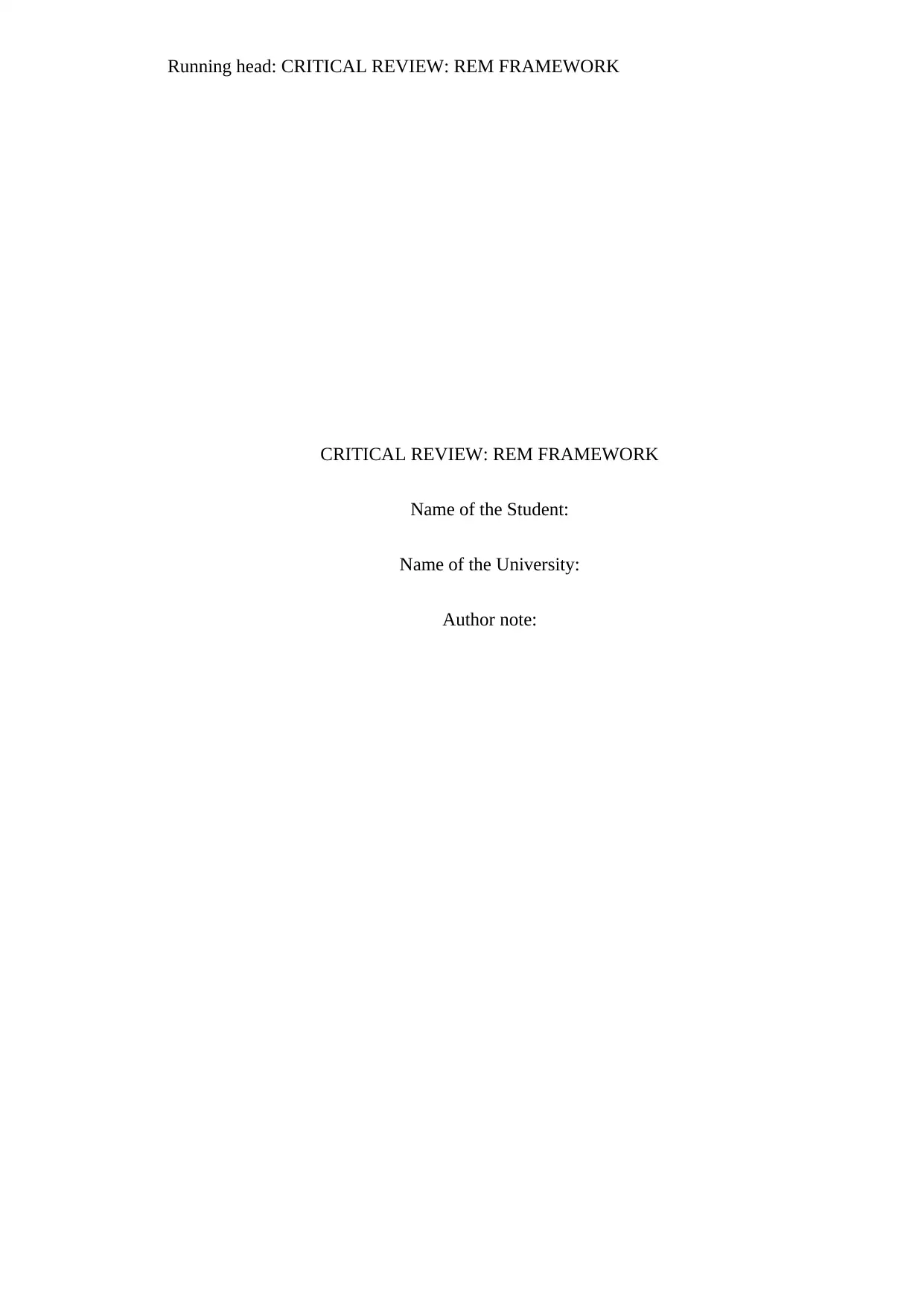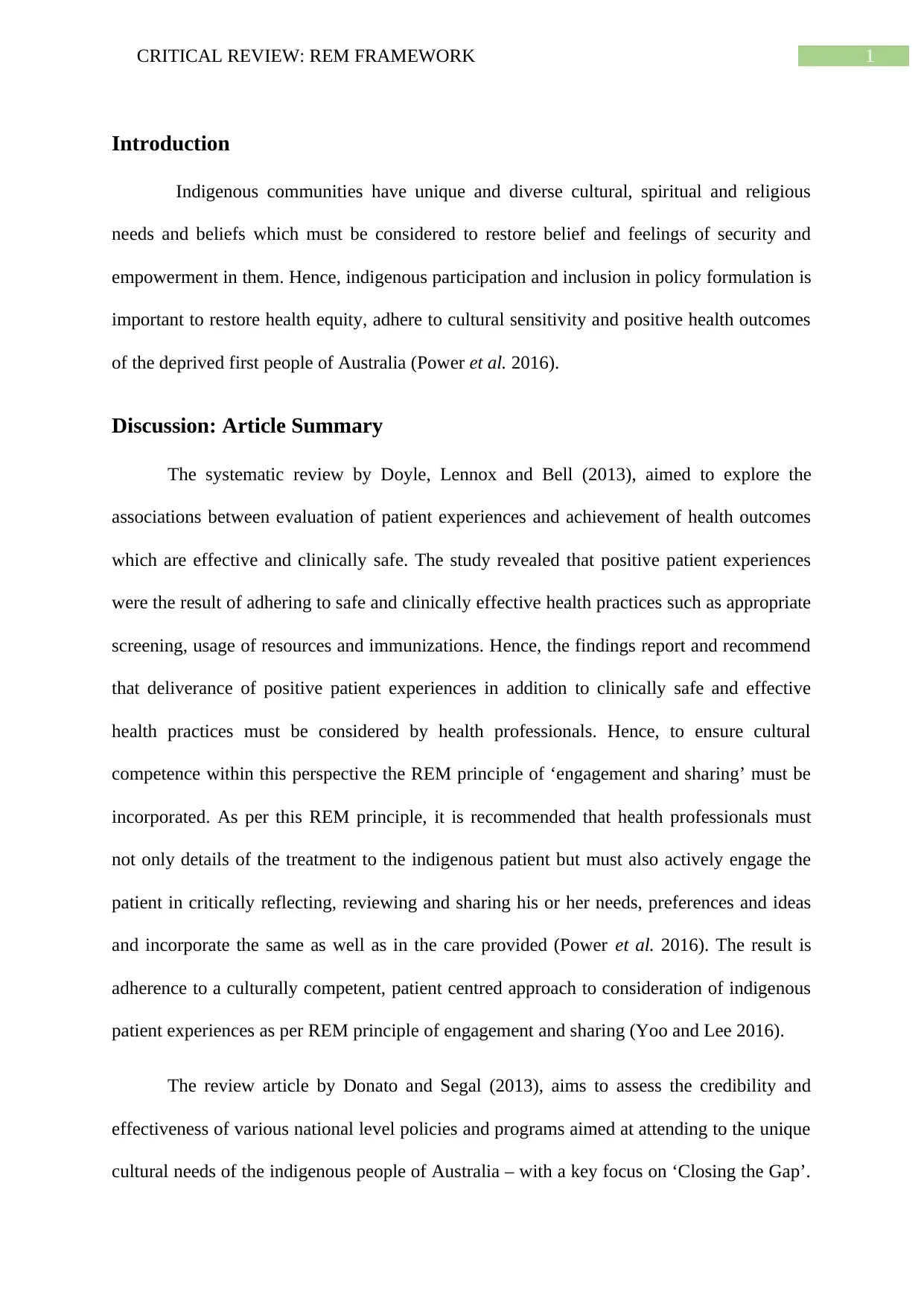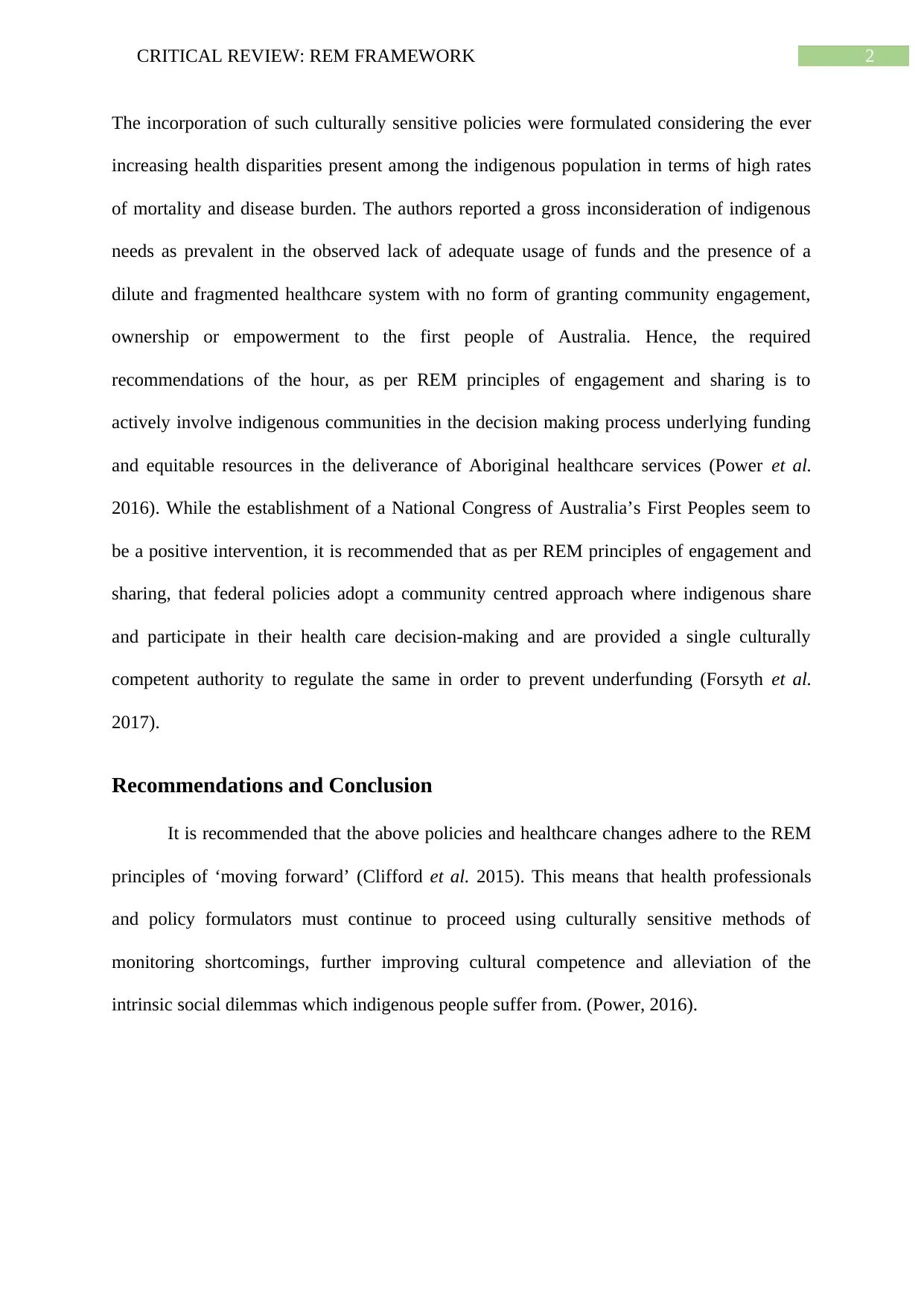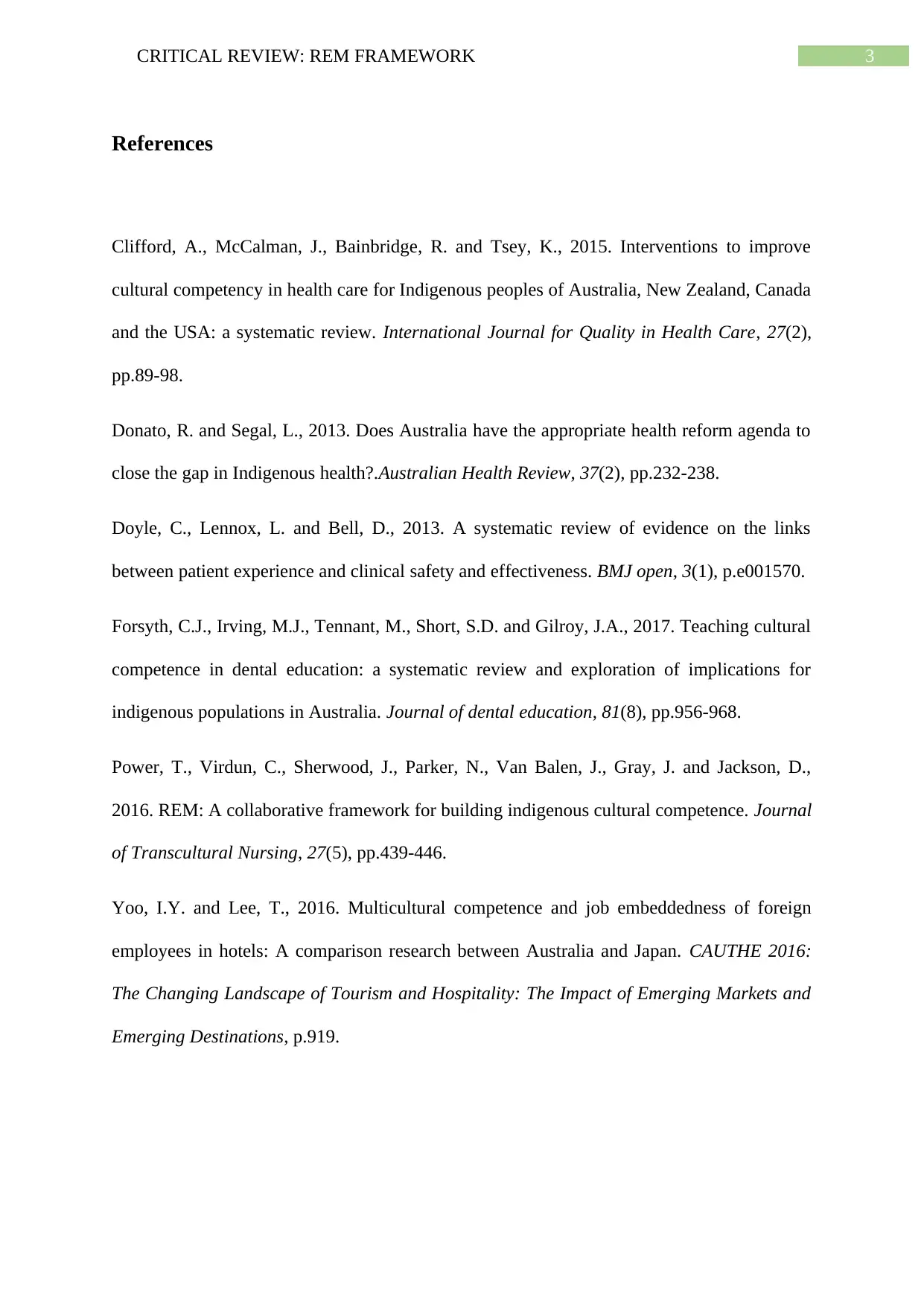Critical Review: REM Framework and Indigenous Healthcare Policies
VerifiedAdded on 2022/12/19
|4
|958
|1
Report
AI Summary
This report provides a critical review of the REM framework, focusing on its application in Indigenous healthcare settings. It examines the importance of cultural competence, patient experience, and the achievement of positive health outcomes. The report summarizes key articles, including a syst...

Running head: CRITICAL REVIEW: REM FRAMEWORK
CRITICAL REVIEW: REM FRAMEWORK
Name of the Student:
Name of the University:
Author note:
CRITICAL REVIEW: REM FRAMEWORK
Name of the Student:
Name of the University:
Author note:
Paraphrase This Document
Need a fresh take? Get an instant paraphrase of this document with our AI Paraphraser

1CRITICAL REVIEW: REM FRAMEWORK
Introduction
Indigenous communities have unique and diverse cultural, spiritual and religious
needs and beliefs which must be considered to restore belief and feelings of security and
empowerment in them. Hence, indigenous participation and inclusion in policy formulation is
important to restore health equity, adhere to cultural sensitivity and positive health outcomes
of the deprived first people of Australia (Power et al. 2016).
Discussion: Article Summary
The systematic review by Doyle, Lennox and Bell (2013), aimed to explore the
associations between evaluation of patient experiences and achievement of health outcomes
which are effective and clinically safe. The study revealed that positive patient experiences
were the result of adhering to safe and clinically effective health practices such as appropriate
screening, usage of resources and immunizations. Hence, the findings report and recommend
that deliverance of positive patient experiences in addition to clinically safe and effective
health practices must be considered by health professionals. Hence, to ensure cultural
competence within this perspective the REM principle of ‘engagement and sharing’ must be
incorporated. As per this REM principle, it is recommended that health professionals must
not only details of the treatment to the indigenous patient but must also actively engage the
patient in critically reflecting, reviewing and sharing his or her needs, preferences and ideas
and incorporate the same as well as in the care provided (Power et al. 2016). The result is
adherence to a culturally competent, patient centred approach to consideration of indigenous
patient experiences as per REM principle of engagement and sharing (Yoo and Lee 2016).
The review article by Donato and Segal (2013), aims to assess the credibility and
effectiveness of various national level policies and programs aimed at attending to the unique
cultural needs of the indigenous people of Australia – with a key focus on ‘Closing the Gap’.
Introduction
Indigenous communities have unique and diverse cultural, spiritual and religious
needs and beliefs which must be considered to restore belief and feelings of security and
empowerment in them. Hence, indigenous participation and inclusion in policy formulation is
important to restore health equity, adhere to cultural sensitivity and positive health outcomes
of the deprived first people of Australia (Power et al. 2016).
Discussion: Article Summary
The systematic review by Doyle, Lennox and Bell (2013), aimed to explore the
associations between evaluation of patient experiences and achievement of health outcomes
which are effective and clinically safe. The study revealed that positive patient experiences
were the result of adhering to safe and clinically effective health practices such as appropriate
screening, usage of resources and immunizations. Hence, the findings report and recommend
that deliverance of positive patient experiences in addition to clinically safe and effective
health practices must be considered by health professionals. Hence, to ensure cultural
competence within this perspective the REM principle of ‘engagement and sharing’ must be
incorporated. As per this REM principle, it is recommended that health professionals must
not only details of the treatment to the indigenous patient but must also actively engage the
patient in critically reflecting, reviewing and sharing his or her needs, preferences and ideas
and incorporate the same as well as in the care provided (Power et al. 2016). The result is
adherence to a culturally competent, patient centred approach to consideration of indigenous
patient experiences as per REM principle of engagement and sharing (Yoo and Lee 2016).
The review article by Donato and Segal (2013), aims to assess the credibility and
effectiveness of various national level policies and programs aimed at attending to the unique
cultural needs of the indigenous people of Australia – with a key focus on ‘Closing the Gap’.

2CRITICAL REVIEW: REM FRAMEWORK
The incorporation of such culturally sensitive policies were formulated considering the ever
increasing health disparities present among the indigenous population in terms of high rates
of mortality and disease burden. The authors reported a gross inconsideration of indigenous
needs as prevalent in the observed lack of adequate usage of funds and the presence of a
dilute and fragmented healthcare system with no form of granting community engagement,
ownership or empowerment to the first people of Australia. Hence, the required
recommendations of the hour, as per REM principles of engagement and sharing is to
actively involve indigenous communities in the decision making process underlying funding
and equitable resources in the deliverance of Aboriginal healthcare services (Power et al.
2016). While the establishment of a National Congress of Australia’s First Peoples seem to
be a positive intervention, it is recommended that as per REM principles of engagement and
sharing, that federal policies adopt a community centred approach where indigenous share
and participate in their health care decision-making and are provided a single culturally
competent authority to regulate the same in order to prevent underfunding (Forsyth et al.
2017).
Recommendations and Conclusion
It is recommended that the above policies and healthcare changes adhere to the REM
principles of ‘moving forward’ (Clifford et al. 2015). This means that health professionals
and policy formulators must continue to proceed using culturally sensitive methods of
monitoring shortcomings, further improving cultural competence and alleviation of the
intrinsic social dilemmas which indigenous people suffer from. (Power, 2016).
The incorporation of such culturally sensitive policies were formulated considering the ever
increasing health disparities present among the indigenous population in terms of high rates
of mortality and disease burden. The authors reported a gross inconsideration of indigenous
needs as prevalent in the observed lack of adequate usage of funds and the presence of a
dilute and fragmented healthcare system with no form of granting community engagement,
ownership or empowerment to the first people of Australia. Hence, the required
recommendations of the hour, as per REM principles of engagement and sharing is to
actively involve indigenous communities in the decision making process underlying funding
and equitable resources in the deliverance of Aboriginal healthcare services (Power et al.
2016). While the establishment of a National Congress of Australia’s First Peoples seem to
be a positive intervention, it is recommended that as per REM principles of engagement and
sharing, that federal policies adopt a community centred approach where indigenous share
and participate in their health care decision-making and are provided a single culturally
competent authority to regulate the same in order to prevent underfunding (Forsyth et al.
2017).
Recommendations and Conclusion
It is recommended that the above policies and healthcare changes adhere to the REM
principles of ‘moving forward’ (Clifford et al. 2015). This means that health professionals
and policy formulators must continue to proceed using culturally sensitive methods of
monitoring shortcomings, further improving cultural competence and alleviation of the
intrinsic social dilemmas which indigenous people suffer from. (Power, 2016).
⊘ This is a preview!⊘
Do you want full access?
Subscribe today to unlock all pages.

Trusted by 1+ million students worldwide

3CRITICAL REVIEW: REM FRAMEWORK
References
Clifford, A., McCalman, J., Bainbridge, R. and Tsey, K., 2015. Interventions to improve
cultural competency in health care for Indigenous peoples of Australia, New Zealand, Canada
and the USA: a systematic review. International Journal for Quality in Health Care, 27(2),
pp.89-98.
Donato, R. and Segal, L., 2013. Does Australia have the appropriate health reform agenda to
close the gap in Indigenous health?.Australian Health Review, 37(2), pp.232-238.
Doyle, C., Lennox, L. and Bell, D., 2013. A systematic review of evidence on the links
between patient experience and clinical safety and effectiveness. BMJ open, 3(1), p.e001570.
Forsyth, C.J., Irving, M.J., Tennant, M., Short, S.D. and Gilroy, J.A., 2017. Teaching cultural
competence in dental education: a systematic review and exploration of implications for
indigenous populations in Australia. Journal of dental education, 81(8), pp.956-968.
Power, T., Virdun, C., Sherwood, J., Parker, N., Van Balen, J., Gray, J. and Jackson, D.,
2016. REM: A collaborative framework for building indigenous cultural competence. Journal
of Transcultural Nursing, 27(5), pp.439-446.
Yoo, I.Y. and Lee, T., 2016. Multicultural competence and job embeddedness of foreign
employees in hotels: A comparison research between Australia and Japan. CAUTHE 2016:
The Changing Landscape of Tourism and Hospitality: The Impact of Emerging Markets and
Emerging Destinations, p.919.
References
Clifford, A., McCalman, J., Bainbridge, R. and Tsey, K., 2015. Interventions to improve
cultural competency in health care for Indigenous peoples of Australia, New Zealand, Canada
and the USA: a systematic review. International Journal for Quality in Health Care, 27(2),
pp.89-98.
Donato, R. and Segal, L., 2013. Does Australia have the appropriate health reform agenda to
close the gap in Indigenous health?.Australian Health Review, 37(2), pp.232-238.
Doyle, C., Lennox, L. and Bell, D., 2013. A systematic review of evidence on the links
between patient experience and clinical safety and effectiveness. BMJ open, 3(1), p.e001570.
Forsyth, C.J., Irving, M.J., Tennant, M., Short, S.D. and Gilroy, J.A., 2017. Teaching cultural
competence in dental education: a systematic review and exploration of implications for
indigenous populations in Australia. Journal of dental education, 81(8), pp.956-968.
Power, T., Virdun, C., Sherwood, J., Parker, N., Van Balen, J., Gray, J. and Jackson, D.,
2016. REM: A collaborative framework for building indigenous cultural competence. Journal
of Transcultural Nursing, 27(5), pp.439-446.
Yoo, I.Y. and Lee, T., 2016. Multicultural competence and job embeddedness of foreign
employees in hotels: A comparison research between Australia and Japan. CAUTHE 2016:
The Changing Landscape of Tourism and Hospitality: The Impact of Emerging Markets and
Emerging Destinations, p.919.
1 out of 4
Related Documents
Your All-in-One AI-Powered Toolkit for Academic Success.
+13062052269
info@desklib.com
Available 24*7 on WhatsApp / Email
![[object Object]](/_next/static/media/star-bottom.7253800d.svg)
Unlock your academic potential
© 2024 | Zucol Services PVT LTD | All rights reserved.





